| Simple tools |
|---|
| Force and movement |
| Wheels |
| Assessments |
Work is said to have been done when force is used to move an object through a distance.
We use machines to help us to do work. This is because machines make work easier.
The work done by a machine depends on two things:
We will investigate two types of simple machines:
inclined planes and single fixed pulleys.
images of inclined planes and single fixed pulleys.
Any flat surface can be referred to as a plane.
When a plane is placed at an angle, it is said to be inclined. Inclined planes are sometimes called ramps or slopes.
It is easier to walk up a gentle slope than a steep slope.
This is because when walking up a gentle slope, we are lifting our bodies only a short height each time we take a step, hence using less energy.
Examples of inclined planes include ramp, wedge, ladder, screw, staircase and road winding uphill.
Images of two types of staircases.
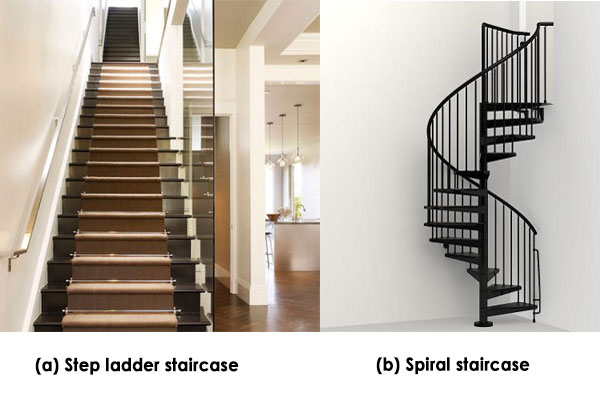
Paths that lead up a hill are either zigzag or spiral.
This helps to reduce the slope of the hill.
This is also a type of inclined plane.
Screws are used for joining pieces of wood together when making furniture.
A screw is an example of an inclined plane.
The screw-type car jack is used for lifting cars up when changing a wheel.
Imagine lifting a car yourself to fix the wheel.
Is it possible?
A wedge is an example of a double-edged inclined plane.
Wedges can be used for various purposes.
For example, an axe used for splitting wood or cutting down big trees is an example of a wedge.
The metal part is in form of a wedge.
-In a single fixed pulley the load distance is equal to the effort distance.
When the load moves 1 metre the effort also moves1 metre.
When the load is 10 kg you require an effort of 10 kg to move it.
-The direction of the load is opposite to that of the effort.
When the load moves up, the effort moves down.
The advantage of this is that the direction of the effort has been changed by the pulley.
This way the total amount of work required to lift the load is reduced.
It is therefore more convenient to use a pulley than carry a load without a pulley.
Image of someone drawing water using a bucket with a string tied and using a pulley.
Staircases are often used to move from one floor to another in a multi-storey building.
A ladder is a structure made up of two long straight pieces of wood or metals joined by cross bars as shown below. The crossbars are called rungs. How does a ladder help to make work easier?
Climbing a wall using a ladder is easier than climbing without. A ladder makes the work of climbing the wall easier.
A pulley is a simple machine that makes work easier by changing the direction and point at which a force works.
Pulleys are wheels with grooves on which ropes move.
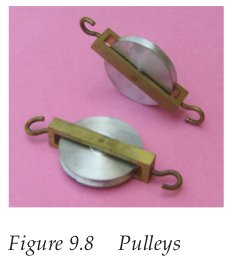
A single fixed pulley helps to make work easier by changing the direction of force to make it more convenient.
Instead of pulling the rope upwards, you pull it downwards yet the load continues to be lifted upwards.
Other areas where single- fixed pulleys are used include
Standard 4
1. Which one of the following maintenance practices is NOT important on a wheelbarrow that is used frequently?
A. Greasing the moving parts frequently
B. Painting of body frequently
C. Tightening loose nuts and bolts frequently
D. Cleaning the wheelbarrow after use
2. Which one of the tools illustrated in the diagram below is suitable for digging a hard ground?
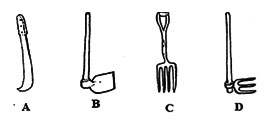
3. Which one of the following pairs of maintenance practices is often carried out on a panga?
A. Cleaning and painting.
B. Cleaning and sharpening.
C. Repairing handle and greasing.
D. Painting and sharpening.
4. Which one of the following tools is most suitable for preparing a seedbed from a hard piece of ground that has couch grass?
A. Garden fork B. Jembe C. Mattock D. Fork jembe
5. Which one of the following maintenance practices should be carried out on a handsaw?
A. Greasing the nuts and bolts B. Sharpening the teeth
C. Washing the blade D. Painting the blade
1. Auma wanted to lift a stone weighing 90N as shown in the diagram below.
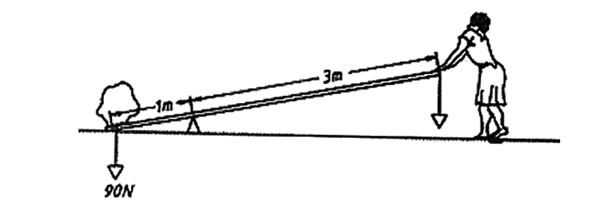
How much effort would she use to lift the 90N load in the arrangement above?
A. 30N B. 90N C. 270N D. 360N
2. Levers are classified as shown in the table below

Which one of the following gives the correct example of a machine from each class?
|
Class I |
Class II |
Class III |
| A. Pair of scissors |
Fishing rod |
Wheelbarrow |
| B. Wheelbarrow |
Pair of scissors |
Fishing rod |
| C. Pair of scissors |
Wheelbarrow |
Fishing rod |
| D. Wheelbarrow |
Fishing rod |
Pair of scissors |
3. The diagram below shows an example of a lever.
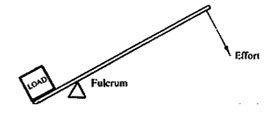
Which of the following levers belong to the same class as the lever shown in the diagram above?

4. The diagram below shows a lid being lifted from a can. The fulcrum is at point
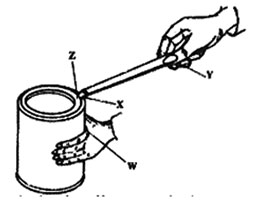
A. W B. X C. Y D. Z
5. The diagram below shows a loaded wheelbarrow being pushed.
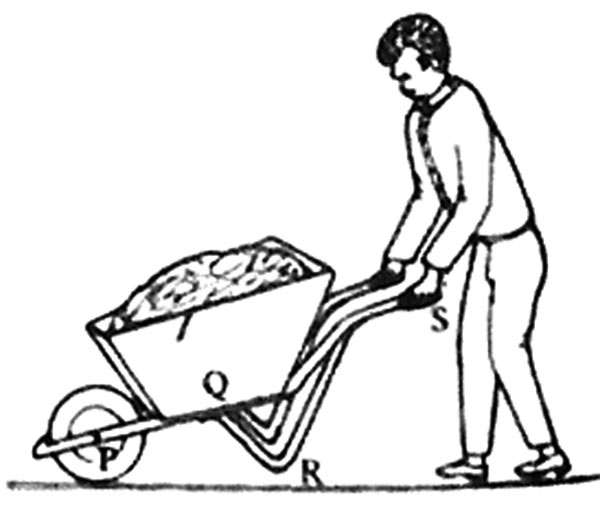
Which one of the following represents the effort distance?
A. QS B. PS C. QR D. PR
6. In which one of the following pairs do both machines have the fulcrum between the load and the effort?
A. Bottle opener, wheelbarrow B. Seesaw, pliers
C. Hammer, nutcracker D. Pair of scissors, fishing rod
7. Which one of the following pairs of levers has the effort between the load and fulcrum?
A. Wheelbarrow and see-saw B. Crowbar and spade
C. Spade and fishing rod D. Tongs and pliers
8. A nursery school child noticed that it was more difficult to open a door by pushing it at point X than a point Y shown in the diagram below.
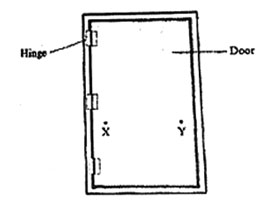
This was because
A. The door was too heavy for the child
B. The effort was very close to the fulcrum
C. The load was far from the fulcrum
D. There was friction in the hinges
9. Which one of the following levers has the positions of load, effort, and fulcrum same as a shovel?
A. Crowbar B. Scissors C. Wheelbarrow D. Fishing rod
10. A machine is a device that
A. Produces energy B. Makes work easier
C. Reduces work done D. Increases effort
11. The diagram below represents a simple machine.
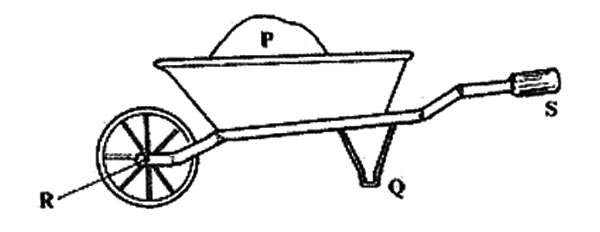
At which point is the fulcrum when the machine is in use?
A. P B. Q C. R D. S
12. The diagram below represents a lever.
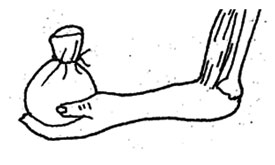
Which one of the following groups of levers have the position of load, effort, and fulcrum the same as the lever shown above?
A. Spade, pair of tongs, fishing line.
B. Scissors, spanner, pliers.
C. Bottle opener, nutcracker, wheelbarrow.
D. Nutcracker, spanner, pliers.
13. The diagram below represents a simple machine used to draw from a well.
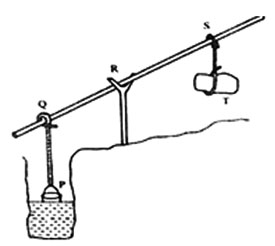
Which one of the following would help to reduce the effort needed to draw the water? Increasing the length of the part labeled
A. RS B. PQ C. QR D. ST
Standard 8
1. Amenge tried different methods of lifting the same stone block from the ground onto a lorry using a rope. Which of the following diagrams shows the arrangement likely to require the LEAST effort to bring the stone?

2. Naposho walked to the top of the hill along the spiral road represented by the diagram below.

If the heights, h, between the points are all the same, the effort used during the climbing was
A. Least between points II and III
B. Least between points III and IV
C. Least between points I and IV
D. The same between all the points
3. Which one of the following simple machines is an example of an inclined plane?
A. Wheel and axle B. Screw jack
C. Gear wheel D. Tyre lever
4. The diagrams below show how inclined planes J, K, L, and M could be used to move the same load to point P

If the same load is moved to point P along the planes, which of the following statements is FALSE?
A. The effort used in each case is the same
B. The amount of work dine in each case is the same
C. The load distance in each case is the same
D. The effort distance in each case is the same.
5. An example of an inclined plane is a
A. Crowbar B. Screw jack C. Fixed pulley D. Wheel and axle
6. The diagram beside represents a simple machine. Which one of the following simple machines is of the same types as the one shown in the diagram?
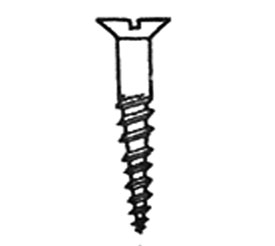
A. Gear wheel B. Crowbar C. Winch D. Inclined plane
7. It is easier riding a bicycle up a steep slope in a zig-zag manner than riding it straight up the slope. A pair of machines which operate in the same way as riding in a zig-zag manner is
A. Gear and screw jack
B. Screw jack and winch
C. Winch and inclined plane
D. Inclined plane and screw jack
8. Which one of the following groups of machines uses the principle of inclined planes?
A. Chisel, wedge, pair of tongs
B. Screw, chisel, bottle opener
C. Chisel, knife, crowbar
D. Screw, wedge, knife